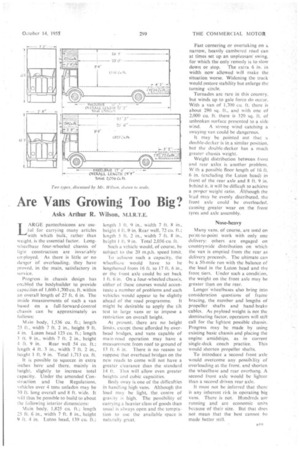Are Vans Growing Too Big?
Page 53

If you've noticed an error in this article please click here to report it so we can fix it.
Asks Arthur R. Wilson, M.I.R.T.E.
LARGE pantechnicons are useful for carrying many articles with which bulk, rather than weight, is the essential factor. Longwheelbase four-wheeled chassis of light construction are invariably employed. ' As there is little or no danger Of overloading, they have proved, in the main, satisfactory in service.
Progress in chassis design has enabled the bodybuilder to provide capacities of 1,600-1,700cu. ft, within an overall length of 27 ft. 6 in. The inside measUrements of Such a van based on a full-forward-6ontro1 chassis can be approximately as follows: Main body. 1,536 Cu. ft.; length 23 ft., width 7 ft. 2 in., height 9 ft. 4 in. Luton head 123 cu. ft.; length 3 ft. 9 in., width 7 ft. 2 in., height
4 ft. 9 in. Rear well 54 cu. ft.; length 4 ft. 3 in., width 7 ft. 2 in., height 1 ft. 9 in. Total L7I3 cu. ft.
It is possible to squeeze in extra inches here and there, mainly in height, slightly to increase total capacity. Under the amended Construction and Use Regulations, vehicles over 4 tons unladen may be 30 ft. long overall and 8 ft. wide. It will thus be possible to build to about the following interior dimensions:
Main body, 1,825 cu. ft.; length 25 ft. 6 in., width 7 ft. 8 in., height 9 ft. 4 in. Luton head, 139 cu. ft.;
• length 3 ft. 9 in., width 7 ft. 8 in., height 4 ft. .9 in. Rear well, 72 Cu. ft.; length 5 ft. 2 in., width 7 ft. 8 in., height I ft. 9 in. Total 2,036 cu. ft.
Such a vehicle would, of course, be subject to the 20 m.p.h. speed limit.
To achieve such a capacity, the 5.vheelbase would have to be lengthened from 16 ft. to 17 ft. 6 in., or the front axle could be set back 1 ft. 6 in. On a four-wheeled chassis, either of these courses would accentuate a number of problems and such vehicles would appear to be slightly ahead of the road programme. It might be desirable to apply the tilt test to large vans or to impose a restriction on overall height.
At present, there are no height limits, except those afforded by overhead bridges, and vans capable of main-road operation may have a measurement from roof to ground of
13 ft. 6 in. There is no reason to suppose that overhead bridges on the new roads to come will not have a greater clearance than the standard
14 ft. This will allow even greater heights and cubic capacities.
Body sway is one of the difficulties in handling high vans. Although the load may be light, the centre of gravity is high. The possibility of carrying a heavier class of goods than usual is always open and the temptation to use the available space is naturally great.
Fast cornering or overtaking on a narrow, heavily cambered road can at times set up an unpleasant swing, for which the only remedy is to slow down or stop. The extra 6 in. in width now allowed will make the situation worse. Widening the track would restore stability but enlarge the turning circle, Tornados are rare in this country, but winds up to gale force do occur. With a van of 1,700 cu. ft. there is about 290 sq. ft., and with one of 2,000 Cu. ft. there is 320 sq. ft. of unbroken surface presented to a side
wind. A strong wind catching a swaying van could be dangerous.
It may be pointed out that a double-decker is in.a similar position. but the double-decker has a much greater chassis weight.
Weight distribution between front and rear axles is another problem. W-th a possible floor length of 16 ft. 6 in. (excluding the Luton head) in front of the rear axle and 8 ft. 9 in. behind it, it will be ditficolt to achieve a proper weight ratio. Although the lead may be evenly distributed, the front axle could be overloaded, causing greater wear on the front tyres and axle assembly.
Nose-heavy Many vans, of course, are used on point-to-point work with only one delivery: others are engaged on countrywide distribution on which the van is emptied from the rear as delivery proceeds. The ultimate can be a 50-mile run with the balance of the load in the Luton head and the front tiers. Under such a condition, the weight on the front axle may be greater than on the rear.
Longer wheelbases also bring into consideration questions of frame bracing, the number and lengths of propeller shafts and hand-brake cables. As payload weight is not the dominating factor, operators Will still call for the lightest possible chassis. Progress may be made by using existing basic chassis and placing the engine amidships, as in current single-deck coach practice. This would shorten propeller shafts.
To introduce a second front axle would overcome any possibility of overloading at the front, and shorten the wheelbase and rear overhang. A second front axle would be lighter than a second driven rear axle.
It must not be inferred that there is any inherent risk in operating big vans. There is not. Hundreds are running and are economic units because of their size. But that does not mean that the best cannot be made better still.




















































































































